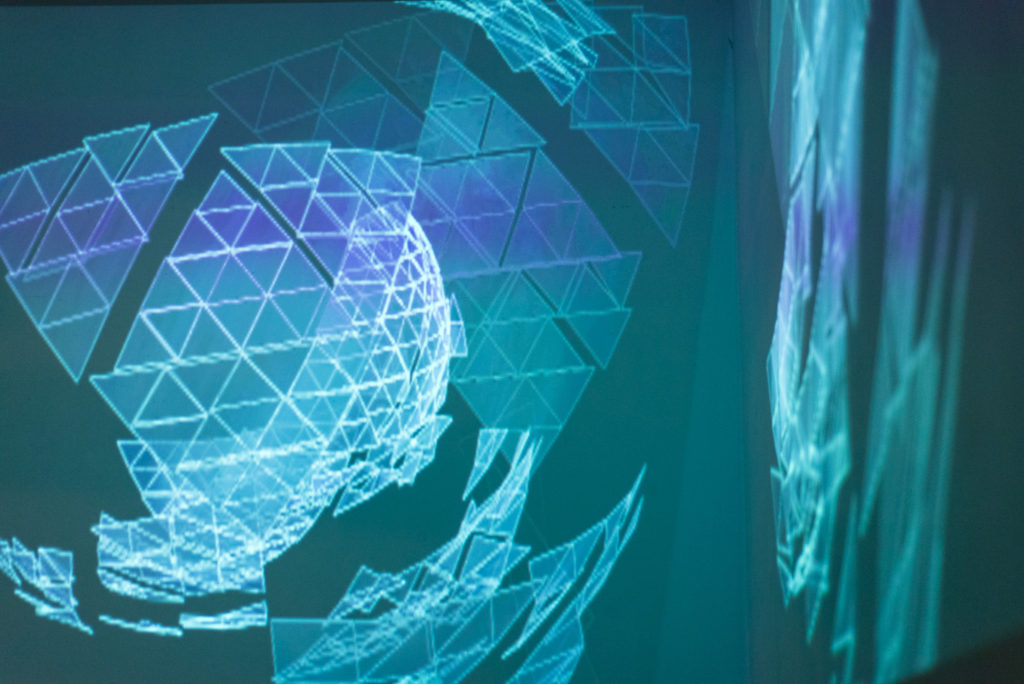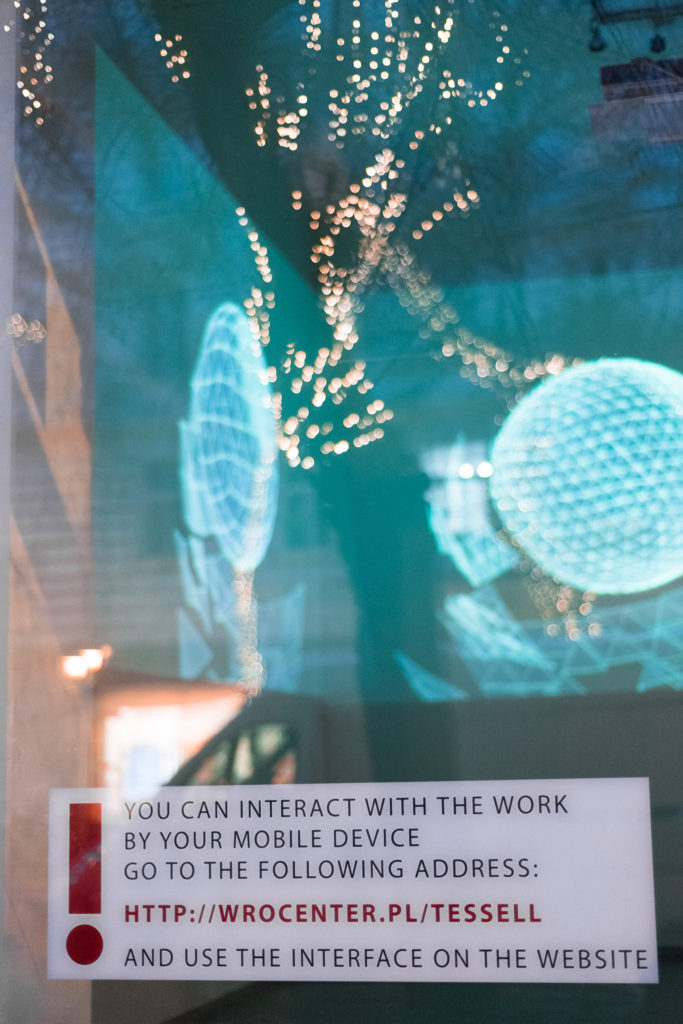Polish artist Paweł Janicki – recognised internationally for his independent media art – presented a huge-scale project at the Platan Gallery in Budapest. The “Tessell” installation calls visitors to engage in multilevel interactions and brings both technologically and conceptually advanced concepts with it. This sphere, with a reference to the architecture of Buckminster Fuller’s domed works, is simultaneously presented at both WRO Art Center in Wroclaw and the Koszyki Hall, Griffin Art Space in Warsaw, which are telematically coupled.
Now “Tessell” can be discovered and transformed by the audience in Budapest as well. We use this opportunity to ask Paweł about his point of view on contemporary interactive media art and his forthcoming projects.
You can interact with the work by your mobile device go to the following address: wrocenter.pl/tessell/

Platan Gallery in Budapest, Tessell.
Patrycja Rup: You are very active as an artist, taking part in multiple projects and applying a wide range of media to your work. Which techniques and materials were primal inspirations for you? Which of these activities are most important to you at the moment?
Paweł Janicki: This is, for many reasons, a difficult question – what I’m showing in public is not what I’m working on at the moment – of course I’m presenting more or less finished works, but at the same time I’m working on new things, so my present is the future from an “outer” perspective.
Anyway, my works are strongly inspired by musical forms, and I’m using a lot of custom made technologies, mostly software I wrote, but I’m experimenting with some space technologies – for example with material engineering. Things related especially to space exploration are very inspiring to me right now and provide new cultural references, not just a reconfiguration of existing stuff. Cultural differences and tensions are always inspiring me – I’m in China now, in the midst of the ChoP project (http://chop-project.com) cooperating and exchanging knowledge with other Polish and Chinese artists – which is great, this is a situation which helps create many new ideas in a very natural way.
PR: You transformed the function of the audience in your works, giving them a role much larger than the role of observer: An opportunity to participate and exert meaningful influence on the final shape of the piece. How do you design this experience? What is the aim of this specific connection with the audience?
PJ: There is definitely something interesting in the word “digital”, which is derived from Latin “digitus” (finger) – in the beginning all math, all computations were a form of self-reflection, scanning the physical parameters of the body: counting fingers, touching things… there was no dualism and body/mind opposition – this is just something which is guiding me. I’m trying make the computations touchable. And I’m also trying involve the audience in triggering intellectual processes starting from physical activities, such as interaction. So, my method is built on top of the basic monism.
PR: Your work “Tessell” is influenced by Buckminster Fuller’s concept of “spaceship Earth”. What do you find most appealing in this theory?
PJ: I’m not sure it’s a theory… I think it is instead a metaphor which creates a proper context for some of the problems humanity is facing now – such as ecological disaster. “Spaceship Earth” forces us to think in very simple categories: we are on the same boat, we have to care for it, or else we will all die, and the whole biosphere with us. Of course, there were some other people from WRO Art Center working on “Tessell” with me – so they may interpret some concepts in a different way, but we all agreed that this “one biosphere on one planet” idea strongly appealed to us.
PR: Do you think interactive art should seek its mission as a politically and socially involved project? Where do you find your works in this context?
PJ: There is definitely a large potential to work within this context. Interactivity as participation, interactivity as critical examination of the social, economic, cultural and technological status quo… Because interactive art is mostly based on the same digital technologies which constitute the shape of a human reality – I can imagine that it is predestined to be a tool for critical analysis. But at the same time interactive art is subjected not only to the same pressures as other arts, but is also based on technologies – the distribution of which is increasingly controlled by private companies. So, it is really hard to be active in this field and still be able to say important things.
PR: Which of your projects do you think have been most significant to your career so far?
PJ: Undoubtedly “Ping Melody”. Maybe not necessarily thinking in terms of career – even if this project has been recognized in many places – but as a kind of hub or a base from which I can wander in different directions.
PR: Regarding the Polish art scene, would you agree with the statement that interactive art is marginalized in it?
PJ: I don’t know… There are a lot of interactive projects now and many active artists. It’s funny, but interaction is still treated as a “new” form of artistic expression. What is really problematic is a lack of critical reflection in the field of “conditional arts” – artistic activities based on computer programming. Curators, theoreticians and gallerists typically can’t “read” the software – they are watching or hearing results produced by the software, but they can’t even touch the phenomenon related to the code itself – it is like trying and understanding music theory without the ability to read the musical notation.

Platan Gallery in Budapest, Tessell.
PR: Which Polish interactive media projects would you recommend to international audiences as significant and representative?
PJ: I spent a huge part of last year traveling around the world, so I’m maybe not the best person to ask about that, but I think that there are a lot of great projects and artists in Poland right now. And because interactive art is very diverse, these projects are rather hard to describe within a fixed number of categories. Moreover, with my colleges from WRO Art Center we are in the process of selecting works for the upcoming WRO biennial, I’m still at a stage of looking at the current situation. But certainly, many of my favorite works will appear in the WRO biennial.
PR: Can you tell us more about your forthcoming projects? Which fields would you like to explore in the future?
PJ: Don’t like to reveal my plans too early but… as I mentioned just now I’m working with the WRO team on the upcoming biennial (inter alia on one of two new installations), and also – this time as a member of the “dæd bɑɪtz” group – I’m preparing parts of a project which may be described as very unusual opera for the Theatre Institute. One of my musical performances in China was recorded and probably will be released as a limited edition CD album very soon. I have some other collaborations in the pipeline, mostly related to music, at different stages of development. For next year I want to develop some projects with Chinese artists and finish and publish (as free software) my custom musical synthesis tool, which I created some time ago and have used in my own projects. There are some more events and projects on the horizon, and they will be announced on my webpage soon.
Intervieved by Patrycja Rup

Platan Gallery in Budapest, Tessell.

Platan Gallery in Budapest, Tessell.
Patrycja Rup – Polish culture manager & journalist. Lives and works in Budapest.

Platan Gallery in Budapest, Tessell.

Platan Gallery in Budapest, Tessell.







